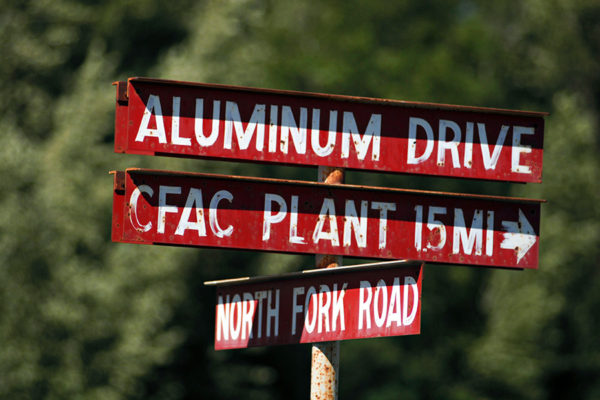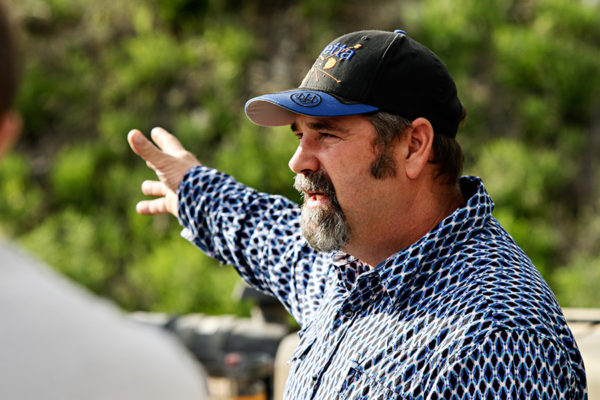The Superfund Sentinel
Mike Cirian has earned a reputation for fairness as the point man for Libby’s high-profile Superfund project, and now he assumes the same role for the fledgling CFAC cleanup
By Clare Menzel
On a cloudy Friday afternoon, EPA Superfund Remedial Project Manager Mike Cirian drove around a Libby neighborhood north of the Kootenai River with country music playing softly on the radio.
“We did that one,” he said, nodding to a square blue house with a trim front yard.
He turned left, pointing out a few more homes with short grass and young trees, and then drove across a bridge to Riverside Park. He pulled into a parking spot and looked out at the green lawn.
“It’s a pretty park,” he said. “The trees will grow in.”
Cirian’s daughter, Holly, got married there in 2012. The trees were even shorter then, and the grass was coming in, but it was still pretty. It was clean.
“Before, the whole site was contaminated,” Cirian said.
Just like the homes and yards he had pointed out, the park was once laced with asbestos. So was much of Libby, formerly one of the world’s largest producers of the mineral vermiculite and now the country’s most high-profile U.S. Environmental Protection Agency Superfund cleanup. Superfund sites, listed on the federal National Priorities List, are designated for critical cleanup due to concerns about contaminants that pose a significant risk to human health and the environment.
This stretch of land by the river had been the site of a W.R. Grace vermiculite processing and exports plant, but now it’s healthy, after crews ripped down old buildings too contaminated to clean and scooped out all the toxic dirt. Now, the community park is a symbol of progress, a tangible mark of how far the resilient City of Eagles has come.
Cirian backed out of the parking spot and drove on. As a remedial project manager since 2005, he oversees planning, safety, budget, and scheduling for the Libby cleanup. He sits in the middle of a complex web, mediating between community members, scientists, contractors, elected officials, and partner government agencies including the Bureau of Land Management, U.S. Forest Service, and Montana Department of Environmental Quality.
The project manager’s most difficult duties are the unwritten ones, like earning the respect of individualists with a deep-seated distrust of the federal government and finding the middle ground in polarized communities. The job also includes breaking down opaque scientific processes for salt-of-the-earth communities who just want to know that their kids will grow up safe, and trying to find solutions when there is a lot of fear and few answers.
“Of all the jobs we have in the regional office at the EPA, one of the most challenging is to be a remedial project manager,” said Bill Murray, the Denver-based EPA Superfund remedial program director. “It takes a rare person to do it all, and do it well, and Mike is one of those rare people.”

Cirian, a 55-year-old Nebraska-born engineer, is a Lincoln County resident, a father of three adult children, an avid hunter, and a Monday night bridge player at the local senior center. He wears cowboy-style boots and a beard, and has an affable, “aw, shucks” kind of laugh. And, as the Superfund delisting of the Libby project comes into sight, he has also begun to manage the nascent cleanup of Glencore’s Columbia Falls Aluminum Company (CFAC) site, which was added to the EPA’s National Priorities List on Sept. 9.
“It’s going to be quite an undertaking there,” said Gayla Benefield, a Libby resident whose parents died from asbestos-related diseases, and who has suffered from asbestos fibers lodged in her lungs. “It’s the same road Libby went down, with people not wanting the cleanup, people not wanting the quote-unquote (Superfund) ‘stigma.’ I was here (in Libby) at the arrival of the EPA, and it wasn’t nice. I think he’ll probably do alright over there. I don’t envy him. It’s going to be difficult.”
There’s no doubt that the path to a clean CFAC site will be long. But Cirian is ready.
More than a decade ago, when Cirian was interviewing for the remedial manager position in Libby, he was asked if he’d reconsider locating to a small town.
“I said, ‘What, I can’t live in Libby?’” Cirian joked. “For people that live in Denver, Libby’s a small town. I grew up in Fort Calhoun, Nebraska. It’s 640 people. At that point, I think they knew it may be a good fit. … I’m the first one that ever got a college degree in our family. My dad had an eighth-grade education and was a truck driver — the best man I ever knew. My mom, she had a high school diploma and was a teacher’s assistant. They definitely wanted more for us than they ever had.”
At first, he worked in construction and at a smelting plant, but after a contract stalled, he decided to become an engineer. After earning his degree from the University of Nebraska Omaha, he got a job in the U.S. Army Corps of Engineers, where he designed water treatment plants. After receiving his professional license, he joined the hazardous waste team, and worked on major cleanups, including the Columbia space shuttle recovery. Then, when the Iraq War broke out, he went overseas with the Corps as a project manager. While he was there, the chief of engineering and construction suffered a stroke, and he was asked to step up.
“That’s a lot of responsibility, but I accepted it,” Cirian said.
He extended his four-month tour by two months, remaining to oversee 200 American employees and nearly 1,500 Iraqi employees who were building schools and hospitals, as well as water, power, and sewage treatment plants.
“I got to see a 14-year-old girl go to school for the first time in her life — the smile on her face,” he said. “Those things are very rewarding.”
When he returned to the U.S., he says he “wanted to do something to help people.” He had some experience working with asbestos, and found the job opening in Libby. A few months later, he and his wife, Deb, moved their family of five out West.
“My whole life has been doing cleanup,” he said. “I care about the plan. I care about the people.”
Sitting 100 miles apart, the two Superfund projects now under Cirian’s watch are completely different, he says. To start, the contamination at Columbia Falls is limited to approximately 960 acres of private land, rather than spread through an entire town with thousands of unique properties. And the stakes are different. In 2009, the EPA declared Libby a public health emergency — the agency’s first and only — and called the situation a “tragedy.” Hundreds of people there have died from asbestos-related diseases, and many more have been sickened.
The Columbia Falls Aluminum Company is “more of a normal Superfund site” in its severity, Murray said. There is concern about cyanide and fluoride contamination lingering in landfills, ponds, soil, and groundwater on site, but preliminary monitoring shows that it is currently contained. The closest residents live .8 miles away, and contaminants have not been recorded at private wells in the nearby Aluminum City neighborhood, nor are there other data to indicate that the health of community members is in danger.
In Libby, the problem was always clear. Vermiculite, a lightweight, insulating, and highly absorbent mineral used in gardening and construction, was woven through town in roof screeds, insulation and plaster. Homeowners and crews could identify many asbestos-containing materials, and cleanup efforts began even before the rigorous scientific review of toxicity values was complete. In Columbia Falls, though, the scope and extent of contamination is uncertain.
“Right now, I don’t even know what I need to clean up at all in Columbia Falls,” Cirian said. “We know there’s some stuff there, but is that landfill holding? Is it doing what it’s supposed to? Will it do what it’s supposed to for a long, long time? Is it on the verge (of breaking)? Or has it already broken? … We really need to find out what’s there. That’s where the rub comes in for the locals, (who say,) ‘Just go clean it up.’ I wish I had that crystal ball that would tell me what it is. But I have a slow magnifying glass, and water samples, that’ll tell me that over time.”
Currently, the CFAC site is in the RI/FS, or remedial investigation/feasibility study, stage. (When speaking, Cirian always notes both the abbreviation and the full phrase, so that the layperson doesn’t get bogged down in alphabet soup.) Over at least the next year, until December 2017, subcontractors with Roux Associates will poke and prod the soil, water, and rock on site from every angle to identify the sources of contamination. They’ll characterize the types of contamination present, and then map out where it’s located. They’ll chart how the groundwater swells and drifts to understand how contaminants might be transported around the site and outside its boundary.

Most of the time during the investigation stage, the land lies in wait — contractors take soil samples from acre-sized grid squares, and water samples from surface water and 64 wells, four times a year. Each sample is then independently verified in a lab in New Jersey. Meaningful analysis can’t be completed until there are many rounds of data. Officials anticipate the feasibility study, the document that will finally elucidate the situation and evaluate cleanup strategies, to be complete by 2021, a timeline that doesn’t sit right with many residents.
“I have a very grave concern, and that is, in this long, lengthy process, time doesn’t seem to be of the essence,” one community member who did not share his name said at a September EPA community meeting. “I don’t feel any sense of urgency. I’d like to see real activity to solve this problem.”
Cirian has vowed time after time that he wishes he could speed up the process.
“It’d be nice if we could take one sample and go, ‘Okay, now we know what the answer is,’” Cirian later said.
But good science — especially the kind that informs long-term, expensive decisions related to the health of human communities — takes time.
“(The community) want(s) to see results,” a Columbia Falls resident, who did not wish to be named but lives near the CFAC site, said at the same meeting. “This affects our lives. … Right now, it’s a trust factor.”
Cirian knows about earning trust. Libby was the ultimate proving ground.
“Some (people), they don’t trust their government; they don’t want the government in their business,” Cirian said. “There’s a group that aren’t even willing to talk to us. We don’t even know why. … We’re in Montana, and some people just want to be left alone. And they have that right to be.”
He’s had his share of critics in Libby, the most skeptical suggesting that he’s “lying” about sample results and “cheating” the process.
“I’ve been told by somebody that I don’t do cleanups to a certain standard because the money I save, I get to keep. Wow,” Cirian said. “If that was true, I’d have retired a long time ago. We’re spending millions here, and I’m not a millionaire — not even close.”
He prefers to make his life “like an open book for people to know about,” which has become habit, a principle. He’s been investigated by the EPA Inspector General several times — Cirian says it’s protocol to thoroughly probe every accusation — but no charges have resulted.
“I know there’s been some controversy,” Lincoln County Commissioner Mark Peck said. “Some people don’t like him. But others do. And that’s the nature of the job.”
Cirian recognizes that he won’t be able to win some people over, and that’s okay with him. It’s not necessarily his job to make everyone happy.
“I like that people trust me,” he said. Still, “the ultimate goal is to make sure that we’re protecting human health and the environment. I know that sounds like such a cliché, but, you know, that’s really what we’re here for.”
After crews remove any toxic materials, the EPA is bound to replace the site’s amenities only in kind — Cirian said he can’t approve betterments. At the Libby site, in particular, where the cleanup is conducted in people’s most personal spaces, that’s been tricky.
“Sometimes, I think people feel they should have gotten more … including me,” former Lincoln County Commissioner and Libby Mayor Tony Berget said. “It’s somebody’s home. You take out a bush or a tree that had been put in by their great grandmother — they might put in a bush, but your yard is never exactly the same.
“At the end of the day, I don’t know if we’ll all be happy,” he continued, adding, “I think Libby is 100 times cleaner than before they arrived.”

Cirian said he’s learned that if “you’re consistent, and you’re giving the same thing to everybody, they appreciate that.” He has found that, over time, trust can be won through such consistency, openness, patience, and communication, the kind that emphasizes listening when answers aren’t easy or available.
“I would say that he does listen; he’s more than willing to sit down and meet with people and talk about an issue,” Berget said. “He’s definitely always available to spend the time. There are very difficult individuals in the world to deal with and he is more than capable at handling himself. It’s definitely a challenge anywhere you go — individuals here are independent and opinionated. … All in all, I think he’s very fair and reasonable.”
Sometimes, Berget said, he wishes Cirian had been more receptive to making changes when families were unhappy with the appearance of their yard or attic after the cleanup. But Berget also said he appreciated that Cirian is “a principled conservative” who didn’t “just throw money at the project.”
Peck said that he has received complaints from residents about the cleanup, but that whenever he’s followed up with Cirian, “he’s been really good to work with.”
“I think overall he’s handled things pretty well,” Peck added. “It’s a tough position to be in, so you have to be kind of tough.”
Critical to Cirian’s hard-won success in Libby is how hard he’s worked to become a real part of the community, outside of his EPA role. His wife works in Libby as a nurse. His daughter still lives in town. He was a Grand Knight of the Knights of Columbus, and is still active in the Catholic fraternal service organization. He’s also the Western Director for the Montana Scholastic Clay Target program, as well as the head coach for the Libby Rock Crushers, a youth clay target-shooting group whose members have won state and regional events.
“When he first came to Libby, he had quite a job ahead of him, and he’s managed to integrate himself into the community, which would be very difficult for anyone — concerning the cleanup, there was a lot of negativity, shall we say, about it,” Benefield, the longtime Libby resident, said. “His family lives here and he’s become a part of the community. When you’re like that, it’s very difficult to think of him even as government.”
Over the last decade, it has become clear to most community members that Cirian is in it for the long haul, and that he wants to do the cleanup right.
“Above and beyond, he has definitely made himself part of the community. … We’re really happy to have him as a resident,” Berget said. Peck agreed, saying, “He cares deeply about the community, and he’s an integral part of the community.”
One of 31 remedial project managers in the region, Cirian is the only manager who doesn’t live in Helena or Missoula. He does plan to remain in Libby, so he won’t have the same hometown advantage in Columbia Falls. Still, he says, “The nice thing with Columbia Falls is I’m already building relationships with folks. Even folks who don’t agree with what we’re doing, we still communicate. If there’s anything I’ve learned over this whole project, communication is the driver of what’s happening. This takes time.”
Even if it takes years to earn trust, Cirian will keep sampling, finding answers, and listening.
“I just think that it’s time to leave it in the hands of the EPA for the time being,” said Mike Shepard, a former CFAC employee and a Columbia Falls city council member, noting that contaminants in the water remain at a safe level for drinking.
“A lot of people have not taken the time (to understand this). They just hear the rumors and they fly off. … (They should) ask informational questions and don’t go off the deep end.”
“I trust Mr. Cirian explicitly,” he added. “I think he’s going to do a good job.”
As the process stipulates, that means waiting, swallowing fear, having faith in science, and trusting that the data collected every three months will provide good answers. There’s no crystal ball.
“When I arrived in Libby, I was told the job would last from three to five years, and I said I would see it through,” Cirian said. “That was almost 12 years ago. It has been a wild ride, but in the end, it has been a very rewarding experience. … I like my job, so that makes it easy to carry that drive to work in Columbia Falls.”
“Knowing you are leaving something better for the future,” he added, “makes it all worthwhile.”